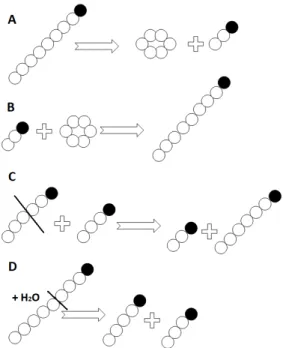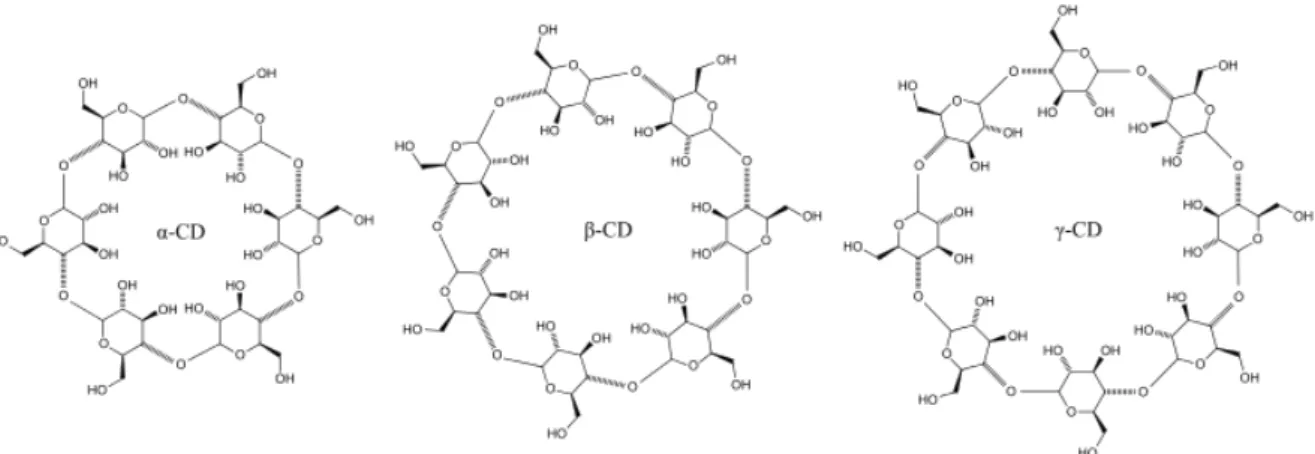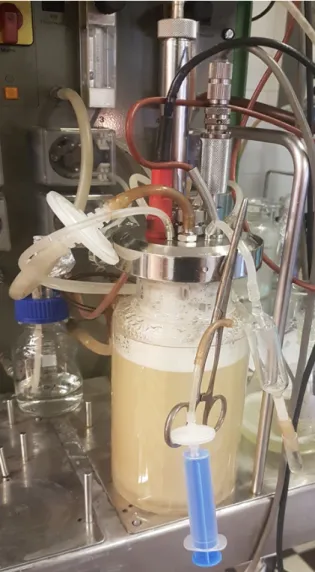1Department of Applied Biotechnology and Food Science, Budapest University of Technology and Economics, M ˝uegyetem rkp. 3, Budapest, 1111, HUNGARY
Cyclodextrins produced by cyclodextrin glycosyltransferase (CGTase) are widely used in the pharmaceutical industry to improve the solubility of drug substances as well as protect them against oxidation. The use of this enzyme in the cos- metics industry is also significant. CGTase is an enzyme that belongs to theα-amylase family, which is part of the group of non-Leloir glycosyltransferases. Enzyme-catalysed transglycosylation reactions may involve cyclization, coupling and disproportionation processes. The enzyme CGTase is mostly used to produce cyclodextrins (CDs). CGTase can produce α-,β- andγ-CDs during transglycosylation reactions, depending on the number of glucopyranose units involved (6,7or 8). The enzyme CGTase can also be used for enzymatic bioconversion, e.g., in the development of alternative sweeten- ers, where the bitter aftertaste of the product is reduced during the enzymatic bioconversion of steviol glycosides, thereby obtaining an even sweeter and more advantageous material. In our research, the enzyme CGTase was produced using different fermentation techniques to compare the activity and amount of CGTase produced by each process and optimize the subsequently planned scale-up. In our studies, the strain DSM 13 ofBacillus licheniformis was used, which produced CGTase extracellularly. During the experiments the batch, fed-batch and semi-continuous fermentation techniques were compared in terms of enzymatic production. All cultivation processes were carried out in a desktop lab scale fermenter.
Keywords: Cyclodextrin glycosyltransferase, fermentation, cyclodextrins,Bacillus licheniformis
1. Introduction
Cyclodextrin glycosyltransferase (CGTase, EC 2.4.1.19) is a starch-degrading enzyme, which is a member of the α-amylase family. The formal name of CGTase is [1,4-α- D-glucan 4-α-D-(1,4-α-glucano)-transferase(cyclizing).
Kuriki et al. [1] reported that CGTase has the same four highly conserved regions as the α-amylases. CGTase catalyses four kinds of transglycosylation reactions (Fig.
1): cyclization, coupling, disproportionation and hydrol- ysis. These reactions are all transglycosylations, in which cyclization is intramolecular, coupling and disproportion- ation are intermolecular, and hydrolysis is the conversion of sugar to H2O [2]. The formation of cyclodextrin (CD) by the enzyme CGTase is an intermolecular transglyco- sylation reaction [3].
Many microorganisms are capable of producing CG- Tase, e.g.,Bacillus macerans [4,5], Bacillus amyloliq- uefaciens [6],Bacillus clarkii [7],Bacillus megaterium [8],Bacillus subtilis[9],Bacillus licheniformis[10,11], Bacillus firmus[12,13],Bacillus circulans[14,15],Bacil- lus ohbensis [16,17], Geobacillus stearothermophilus [18],Thermoanaerobacter sp. [19],Klebsiella pneumo- niae, andKlebsiella oxytoca [20].
*Correspondence:naron@f-labor.mkt.bme.hu
Figure 1:CGTase-catalysed reactions: A: cyclization, B:
coupling, C: disproportionation, D: hydrolysis
Figure 2:General structure of cyclodextrins (n: number of glucopyranose units,n= 6α-CD,n= 7β-CD,n= 8γ-CD) (Figure adapted from: https://commons.wikimedia.org/wiki/File:Cyclodextrin.svgCC BY-SA 3.0) (08.07.2019) )
The molecular weight of CGTases may vary from60 to110kDa, typically its proteins have a mass of75kDa [21]. The most important demand of metal ions for them is Ca2+, which protects the protein against heat denatura- tion. Most CGTases are strongly inhibited by Zn2+, Cu2+
and Fe2+[22].
Cyclodextrins, produced from starch or its deriva- tives via enzymatic conversion, proceed through an in- tramolecular transglycosylation reaction using CGTases and to a lesser extent α-amylases [3]. They are cyclic oligosaccharides composed of α-1,4-glycosidic-linked glucosyl residues [23]. Three different types of cyclodex- trins exist and are characterised according to the num- ber of glucosyl residues in the molecule: α-,β- andγ- cyclodextrins consist of6,7and8glucose units, respec- tively (Fig. 2). Cyclodextrins are cyclic molecules with a hydrophilic exterior and a hydrophobic cavity that en- ables them to form specific inclusion complexes with small hydrophobic molecules [24]. Cyclodextrins are chi- ral non-reducing oligosaccharides. Glucose is the decom- position product of all cyclodextrins in acidic solutions.
The rate of hydrolysis follows the order of γ >
β > α. Under acidic conditions, cyclodextrins are more slowly hydrolyzed than maltooligosaccharides. The gly- cosidic bonds in the cyclodextrins can be hydrolyzed by α-amylase, but β-amylase is unable to perform this hy- drolysis. The rate of enzymatic hydrolysis is the fastest forγ-CD, followed byβ- then α-CD. All CDs are very stable and soluble in alkaline solutions at high pH. CDs are more resistant to acid or alkaline degradation than starch. CDs do not even degradate at temperatures as high as that of caramelization (> 200◦C, sterilization) under both dry or aqueous conditions of between pH2and12.
They are also stable up to250◦Cunder an inert atmo- sphere of, for example, nitrogen [20,25,26].
The widespread use of cyclodextrins is due to their specific structure. Since each guest molecule is uniquely surrounded by the CD (or one of its derivatives), it is microencapsulated from a molecular microscopic point of view. This can result in beneficial changes to the chemical and physical properties of guest molecules, e.g.,
light- or oxygen-sensitive materials can be stabilized;
very volatile substances fixed; the chemical reactivity of molecules modified; the solubility of materials improved;
changes between phases achieved from liquid substances into powders; degradation of microorganisms avoided;
bad smells and tastes masked; and pigments or colors of materials coated. As a result of these characteristics, CDs (and their derivatives) can be used in analytical chemistry, agriculture, the pharmaceutical as well as food industries and other masking areas. CGTase can be used for the transglycosylation of stevioside to rebaudioside through which the edulcorant quality can also be improved by increasing the substitution of steviol glycoside with the help of cornstarch hydrolyzate and CGTase [27–30].
2. Materials and Methods 2.1 Cultivation of the bacteria
The applied bacterial strain was Bacillus licheniformis B.01470 (DSM 13) purchased from the National Col- lection of Agricultural and Industrial Microorganisms in Hungary.Bacillus licheniformisis a Gram-positive, rod- shaped, endospore forming, facultatively anaerobic bac- teria. Nutrient agar was used to maintain the bacterium in Petri dishes [31]. In our research, three types of fermenta- tion techniques for the production of CGTase were com- pared: batch, fed-batch, and semi-continuous fermenta- tion techniques. All cultivation processes were carried out in a benchtop lab scale fermenter (Fig. 3) (Biostat Q, B.
Braun Biotech International, Germany). In the fed-batch fermentation, after24hours15v/v % of the medium was fed into the bioreactor. During the semi-continuous fer- mentation at the end of each cycle,80% of the broth was replaced by fresh media.
For the experiments in the bioreactor, Horikoshi II medium was used for the cultivation of bacteria contain- ing1.0% soluble starch,0.5% peptone,0.5% yeast ex- tract,0.1% K2HPO4,0.02% MgSO4•7H2O, and1.0% Na2CO3(all concentrations are given in w/v in distilled water) [32].
Figure 3:The bioreactor used in the experiments
2.2 The modelling of microbial growth
In order to monitor the growth of bacterial cells, samples were taken during fermentations and the optical density (OD) measured at600nm.
Microbial growth is described by µx= 1
x dx
dt, (1)
whereµxis the specific growth rate of the microbe. It was evaluated through fitting the generalized logistic function
Z= Zmax
1 + exp(a+bt+ct2+dt3) (2) to the measured cell dry weight (CDW) values (calculated from at OD600). To fit the curve, SigmaPlot Version 12.0 software was applied. If the coefficient of determination (R2) was not high enough, the last two members of the generalized logistic function were omitted resulting in
Z = Zmax
1 + exp(a+bt), (3)
Figure 4:Colorimetric analysis of CGTase activity
which also corresponds to the modified Monod model.
The derivative of the fitted function is dZ
dt =−Z
1− Z Zmax
dH
dt (4)
where
dH
dt =b+ 2ct+ 3dt2 (5) is the derivative of the internal function. The auxiliary variableZ inEq. 2,3, and4wasx(biomass in g/L),S (substrate in g/L), andPi (product in g/L), respectively, whileZmaxwasxmax,S0andPi,max, respectively. If the fit was successful, then, by using determined constants of the model, the velocities and specific growth rates could be calculated by derivation fromEq. 4.
2.3 Measurement of CGTase activity
During the fermentations, samples were regularly ex- tracted into Eppendorf tubes, which were centrifuged at 12,000 rpm for 6 minutes, then the cell-free supernatants were used to determine the enzyme activity.
The measurement of extracellular CGTase activity was adapted from the method of Kaneko et al. [33]
with slight modifications (with a reduced concentration of phenolphtalein). The colorimetric reaction (Fig. 4) was measured by a spectrophotometer at550nm.
The experiments were conducted in 15 ml centrifuge tubes in a water bath at40◦C. First,4.5ml50mM Tris- HCl buffer (pH = 9) was added containing a1% (w/v) water-soluble starch suspension, then0.5ml of cell-free supernatant containing the extracellular CGTase enzyme was introduced and homogenized thoroughly with a vor- tex mixer.
Then four0.5ml samples were taken from each tube which were boiled for 5 minutes to inactivate the en- zyme. The boiled samples were transferred into2ml cu- vettes that contained a staining solution (1.2ml0.06mM phenolphthalein in 0.5 M Na2CO3 solution). Four ab- sorbances at550nm of a given assay were plotted against time and the gradient (mmol/min) converted into enzyme activity with the help of a molar extinction coefficient (32,263M−1cm−1) resulting in the CGTase activity in unit/ml supernatant.
Figure 5:Microbial growth during the batch fermentation
Figure 6:Microbial growth during the fed-batch fermen- tation
3. Results and Discussion 3.1 Batch fermentation
Fig. 5shows the microbial growth during the batch fer- mentation and also represents the changes in the specific growth rate. The maximum value of the specific growth rate was0.531/h. At the end of the fermentation, the fi- nal activity of CGTase was0.3U/ml and the productivity was11.8mU/(ml h).
3.2 Fed-batch fermentation
Fig. 6represents microbial growth during the fed-batch fermentation. Unfortunately, due to poorly scheduled sampling, it was not possible to adjust the generalized lo- gistic equation, therefore, it was impossible to calculate the specific growth rate. A fresh medium of15% was in- jected after24hours. The final enzyme activity was0.5 U/ml and the enzyme productivity was12.3mU/(ml h).
3.3 Semi-continuous fermentation
The semi-continuous fermentation is shown in Fig. 7, which consisted of 3 cycles. The highest value of the maximum growth rate was during the first cycle (0.5 1/h).
As the fermentation progressed, the maximum specific growth rate decreased.
Figure 7:Optical density and specific growth rate changes during the semi-continuous fermentation
Figure 8:CGTase activities at the end of each cycle
Fig. 8shows that the enzyme activity of CGTase in- creased as the fermentation progressed.
3.4 Comparison of the different fermentation techniques
Table 1summarizes the enzyme activities and productiv- ities achieved by each fermentation technique. The maxi- mum specific growth rates reached in the batch and semi- continuous fermentations were approximately the same, which is characteristic of when the microorganism can multiply.
The enzyme activities at the end of the fermentations
Table 1:Comparison between the results of the different fermentation techniques
Type µmax
[1/h]
Final enzyme activity [U/ml]
Productivity [mU/(ml h)]
Batch 0.53 0.3 11.8
Fed-batch n.d. 0.5 12.3
Semi-
continuous 0.50 2.4 29.95±0.3
In our experiments, the effect of the fermentation tech- nique on the activity of the produced enzyme CGTase was investigated. There was no significant difference between the activities of the produced CGTase and productivities of the systems when the batch and fed-batch fermenta- tions were compared. In contrast, bacteria produced a much more active enzyme during the semi-continuous fermentation, moreover, the productivity of this system was also significantly higher than that of the other two fermentation techniques.
From the results, it can be assumed that the microbes produce the enzyme during the exponential growth phase, since no significant difference was observed between the batch and fed-batch fermentations. Meanwhile, a repeated exponential growth phase resulted in a much higher activity and productivity. This suggests that CG- Tase production follows growth associated-type product formation.
Acknowledgement
The research was supported by the Gedeon Richter’s Talentum Foundation, founded by Gedeon Richter Plc.
(Gedeon Richter PhD fellowship).
REFERENCES
[1] Kuriki, T.; Imanaka, T.: The concept of the α- amylase family: Structural similarity and common catalytic mechanism,J. Biosci. Bioeng.199987(5), 557–565DOI: 10.1016/S1389-1723(99)80114-5
[2] Kobayashi, S.: Cyclodextrin producing enzyme (CGTase) in Park, K.-H.; Robyt, J. F.; Choi, Y.- D. (eds.): Enzymes for carbohydrate engineering (Progress in Biotechnology) 19961223–41 (Else- vier, Amsterdam, The Netherlands)ISBN: 978-0-444- 82408-0 DOI: 10.1016/S0921-0423(96)80360-1
[3] van der Veen, B. A.; van Alebeek, G.-J. W. M.;
Uitdehaag, J. C. M.; Dijkstra, B. W.; Dijkhuizen, L.: The three transglycosylation reactions catalyzed by cyclodextrin glycosyltransferase from Bacillus circulans(strain 251) proceed via different kinetic mechanismsEur. J. Biochem.2000267(3) 658–665
DOI: 10.1046/j.1432-1327.2000.01031.x
[4] Isao, K.; Yoshida, N.: Method of producing β- cyclodextrin 1996 US 5556775, United States Patent and Trademark Office https://patents.
google.com/patent/US5556775A/en
10.1007/BF00268199
[7] Wu, D.; Chen, S.; Wang, N.; Chen, J.; Wu, J.:
Gamma-cyclodextrin production using cyclodex- trin glycosyltransferase fromBacillus clarkii7364 Appl. Biochem. Biotechnol.2012167(7) 1954–1962
DOI: 10.1007/s12010-012-9741-5
[8] Pishtiyski, I.; Popova, V.; Zhekova, B; Characteri- zation of cyclodextrin glucanotransferase produced byBacillus megaterium Appl. Biochem. Biotechnol.
2008144263–272DOI: 10.1007/s12010-007-8009-y
[9] Cheirsilp, B.; Kitcha, S.; Maneerat, S.: Kinetic characteristics ofβ-cyclodextrin production by cy- clodextrin glycosyltransferase from newly isolated Bacillussp. C26Electron. J. Biotechnol.201013(4)
DOI: 10.2225/vol13-issue4-fulltext-6
[10] Bonilha, P. R. M.; Menocci, V.; Goulart, A. J.;
Polizeli, M. L. T. M.; Monti, R.: Cyclodextrin gly- cosyltransferase fromBacillus licheniformis: Opti- mization of production and its properties Braz. J.
Microbiol. 2006 37(3) 317–323 DOI: 10.1590/S1517- 83822006000300022
[11] Thombre, R. S.; Kanekar, P. P.: Synthesis of β- Cyclodextrin by Cyclodextrin glycosyl transferase produced byBacillus licheniformisMCM–B1010J.
Microbiol. Biotech. Res.20133(1) 57–60
[12] Matioli, G.; Zanin, G. M.; De Moraes, F. F.: In- fluence of substrate and product concentrations on the production of cyclodextrins by cgtase ofBacil- lus firmus, strain No. 37Appl. Biochem. Biotechnol.
2002 98(1–9) 947–961 DOI: 10.1385/ABAB:98-100:1- 9:947
[13] Gawande, B. N.; Goel, A.; Patkar, A. Y.;
Nene, S. N.: Purifcation and properties of a novel raw starch degrading cyclomaltodextrin glucanotransferase from Bacillus firmus Appl.
Microbiol. Biotechnol. 1999 51 504–509 DOI:
10.1007/s002530051424
[14] Pinto, F. S. T.; Flôres, S. H.; Ayub, M. A. Z.; Hertz, P. F.: Production of cyclodextrin glycosyltransferase by alkaliphilic Bacillus circulans in submerged and solid-state cultivationBioprocess Biosyst. Eng.
200730(5) 377–382DOI: 10.1007/s00449-007-0134-z
[15] Iyer, J. L.; Shetty, P.; Pai, J. S.: Immobilisa- tion of cyclodextrin glucanotransferase fromBacil- lus circulans ATCC 21783 on purified seasand J.
Ind. Microbiol. Biotechnol. 200330(1) 47–51DOI:
10.1007/s10295-002-0009-x
[18] Shiosaka, M.: Heat stable cyclodextrin glycosyl- transferase 1976US 3988206, United States Patent and Trademark Officehttps://patents.google.com/
patent/US3988206A/en
[19] Martín, M. T.; Plou, F. J.; Alcade, M.; Balles- teros, A.: Immobilization on Eupergit C of cy- clodextrin glucosyltransferase ( CGTase ) and prop- erties of the immobilized biocatalystJ. Mol. Catal.
B Enzym.200321(4-6) 299–308DOI: 10.1016/S1381- 1177(02)00264-3
[20] Wimmer, T.: Cyclodextrins in Ullmann’s Ency- clopedia of Industrial Chemistry 2012 11 DOI:
10.1002/14356007.e08_e02
[21] Uitdehaag, J. C. M.; Kalk, K. H.; van der Veen, B. A.; Dijkhuizen, L.; Dijkstra, B. W.: The cycliza- tion mechanism of cyclodextrin glycosyltransferase (CGTase) as revealed by aγ-cyclodextrin-CGTase complex at 1.8-Å resolution J. Biol. Chem. 1999 274(49) 34868–34876DOI: 10.1074/jbc.274.49.34868
[22] Thangadurai, D.; Sangeetha, J. (eds.): Industrial Biotechnology, Sustainable Production and Biore- source Utilization 2017 (Apple Academic Press, Oakville, Canada),ISBN: 978-1-771-88262-0
[23] Biwer, A.; Antranikian, G.; Heinzle, E.: Enzy- matic production of cyclodextrinsAppl. Microbiol.
Biotechnol.200259(6) 609–617DOI: 10.1007/s00253- 002-1057-x
[24] Szejtli, J.: Introduction and general overview of cy- clodextrin chemistryChem. Rev.199898(5) 1743–
DOI: 10.1016/S0032-9592(03)00258-9
[28] Singh, M.; Sharma, R.; Banerjee, U. C.: Biotech- nological applications of cyclodextrins Biotech- nol. Adv.200220(5–6) 341–359DOI: 10.1016/S0734- 9750(02)00020-4
[29] Li, S.; Li, W.; Xiao, Q. Y.; Xia, Y.: Transglycosyla- tion of stevioside to improve the edulcorant quality by lower substitution using cornstarch hydrolyzate and CGTaseFood Chem.2013138(2–3) 2064–2069
DOI: 10.1016/j.foodchem.2012.10.124
[30] Kochikyan, V. T.; Markosyan, A. A.; Abelyan, L.
A.; Balayan A. M.; Abelyan, V. A.: Combined en- zymatic modification of stevioside and rebaudioside AAppl. Biochem. Microbiol.200642(1) 37–43DOI:
10.1134/S0003683806010030
[31] DSMZ Nutrient agar (n.d.) Retrieved from
https://www.dsmz.de/microorganisms/medium/pdf/
DSMZ_Medium1.pdf, date accessed: 2019.10
[32] Park, C. S.; Park, K. H.; Kim, S. H.: A rapid screen- ing method for alkaline β-cyclodextrin glucan- otransferase using phenolphthalein-methyl orange- containing solid mediumAgric. Biol. Chem.1989 53(4) 1167–1169DOI: 10.1080/00021369.1989.10869443
[33] Kaneko, T.; Kato, T.; Nakamura, N.; Horikoshi, K.:
Spectrophotmetric determination of cyclization ac- tivity ofβ-cyclodextrin-forming cyclomaltodextrin glucanotransferase J. Jpn. Soc. Starch Sci. 1987 34(1) 45–48DOI: 10.5458/jag1972.34.45


